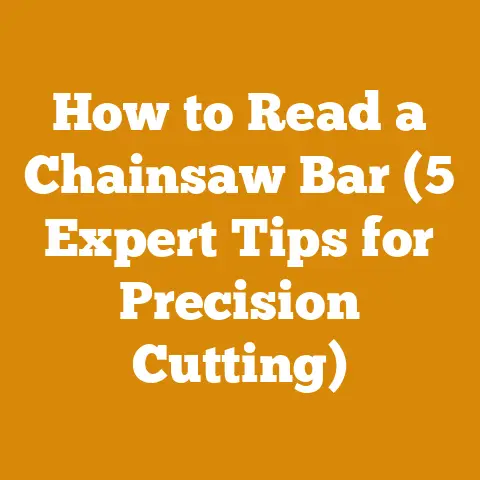How to Get Rid of Invasive Garlic Mustard (Expert Tree Care Tips)
Have you ever felt like you’re fighting a losing battle? Like an unseen enemy is slowly strangling the very life out of your backyard, your woods, your peace of mind? That’s how I felt when I first encountered garlic mustard. It’s a silent invader, a master of disguise, and a relentless competitor for the resources that your beloved trees and native plants desperately need.
But don’t despair! This isn’t just another doom-and-gloom article. I’ve wrestled with this leafy foe myself, and I’m here to share my hard-earned knowledge and practical strategies for reclaiming your land. We’ll dive deep into effective removal methods, explore the science behind this invasive species, and, most importantly, discuss the costs – both in time and money – associated with garlic mustard eradication.
Get ready to arm yourself with the knowledge you need to win this war. Let’s get started!
Understanding the Enemy: Garlic Mustard Demystified
Before we launch our offensive, let’s understand our adversary. Garlic mustard ( Alliaria petiolata) is a biennial herb native to Europe and Asia. It was introduced to North America in the 1860s, allegedly for culinary and medicinal purposes. Little did they know the havoc it would wreak!
Why is Garlic Mustard So Bad?
Garlic mustard possesses several characteristics that make it a particularly aggressive invasive species:
- Rapid Reproduction: A single plant can produce thousands of seeds, which can remain viable in the soil for up to seven years.
- Adaptability: It thrives in a wide range of habitats, from sun-drenched meadows to shady forests.
- Allelopathy: Garlic mustard releases chemicals into the soil that inhibit the growth of other plants, effectively poisoning its competition. This is a particularly insidious trait that allows it to dominate understories and suppress native vegetation.
- Lack of Natural Predators: Native herbivores and insects have not evolved to feed on garlic mustard, leaving it virtually unchecked.
Identifying Garlic Mustard: A Field Guide
Proper identification is crucial. Here’s what to look for:
- First-Year Plants: Form a rosette of kidney-shaped, scalloped leaves close to the ground. These rosettes are easily overlooked, but they are the starting point of the infestation.
- Second-Year Plants: Develop a flowering stalk that can reach up to four feet tall. Leaves are more triangular and sharply toothed.
- Flowers: Small, white, and four-petaled, clustered at the top of the stalk.
- Smell: Crushed leaves emit a distinct garlic odor, hence the name. This is your most reliable identification tool.
The Battle Plan: Effective Garlic Mustard Removal Methods
Now for the good stuff! There are several methods for controlling garlic mustard, each with its own pros and cons. The best approach depends on the size of the infestation, your available resources, and your personal preferences. I’ve personally used all of these methods, so I can share some insights from the trenches.
Hand-Pulling: The Tried-and-True Method
Hand-pulling is the most effective method for small to medium-sized infestations, especially when the soil is moist.
- Technique: Grasp the plant at the base, close to the soil line, and pull firmly and steadily. Ensure you remove the entire root system. Any remaining root fragments can re-sprout.
- Timing: The best time to pull is in the spring, before the plants go to seed. This prevents the spread of new seeds and weakens the existing population. I usually dedicate a few weekends in April and May to this task.
- Disposal: Bag the pulled plants and dispose of them properly. Do not compost them, as the seeds can survive the composting process. Check with your local municipality for guidelines on disposal of invasive species.
- Cost: Primarily labor. Gloves are essential (around $10-$20 for a good pair), and heavy-duty garbage bags will cost around $5-$10 per pack.
My Experience: I’ve spent countless hours on my hands and knees, pulling garlic mustard. It’s tedious, but incredibly satisfying. One year, I even organized a “Garlic Mustard Pulling Party” with my neighbors. We turned it into a social event, complete with snacks and friendly competition. It was a great way to get the job done and build community spirit.
Cutting: A Stopgap Measure
Cutting the flowering stalks can prevent seed production, but it will not kill the plant. This method is best used in conjunction with other control measures.
- Technique: Cut the stalks at ground level with a sharp knife or pruning shears.
- Timing: Cut the stalks just before or during flowering.
- Disposal: Bag the cut stalks and dispose of them properly.
- Cost: Primarily labor and the cost of a good pair of pruning shears ($20-$50).
My Experience: Cutting is a good option for areas that are difficult to access for hand-pulling, such as steep slopes or dense undergrowth. However, it’s important to remember that this is only a temporary solution. You’ll need to follow up with other methods to completely eradicate the garlic mustard.
Herbicide Application: A Last Resort
Herbicides should be used as a last resort, as they can have negative impacts on non-target plants and the environment.
- Herbicide Selection: Glyphosate-based herbicides are generally effective against garlic mustard. However, they are non-selective, meaning they will kill any plant they come into contact with. Triclopyr is a selective herbicide that targets broadleaf plants, making it a better option for areas with desirable grasses.
- Application: Apply the herbicide directly to the foliage of the garlic mustard plants, following the manufacturer’s instructions carefully. Avoid spraying on windy days to prevent drift.
- Timing: The best time to apply herbicide is in the fall, when the garlic mustard plants are actively growing and transporting nutrients to their roots.
- Cost: The cost of herbicide varies depending on the type and quantity. A quart of glyphosate concentrate can cost around $20-$40. You’ll also need a sprayer, which can range from $20 for a hand-held model to $100 or more for a backpack sprayer. Personal protective equipment, such as gloves, goggles, and a respirator, is also essential and can cost an additional $30-$50.
My Experience: I’ve only used herbicides on garlic mustard in very limited situations, such as when dealing with a large, dense infestation in a sensitive area. I always try to use the most targeted approach possible and take precautions to protect non-target plants. If you’re considering using herbicides, I strongly recommend consulting with a qualified professional to ensure that you’re using the right product and applying it safely and effectively.
Solarization: A Non-Chemical Approach
Solarization involves covering the infested area with clear plastic to trap heat and kill the plants.
- Technique: Cover the area with clear plastic sheeting, making sure to seal the edges tightly with soil or rocks.
- Timing: Solarization is most effective during the hottest months of the year (June-August).
- Duration: Leave the plastic in place for at least 6-8 weeks.
- Cost: The cost of plastic sheeting varies depending on the size of the area you need to cover. A roll of heavy-duty plastic can cost around $50-$100.
My Experience: I’ve used solarization to control garlic mustard in small garden beds. It’s a relatively easy and effective method, but it does require patience. The downside is that it kills everything under the plastic, so it’s not suitable for areas with desirable plants.
Prescribed Burns: A More Aggressive Option
Prescribed burns can be an effective way to control garlic mustard in large, open areas.
- Technique: A controlled burn is conducted under specific weather conditions to kill the garlic mustard plants and stimulate the growth of native vegetation.
- Expertise: Prescribed burns should only be conducted by trained professionals.
- Cost: The cost of a prescribed burn varies depending on the size of the area, the complexity of the terrain, and the availability of qualified personnel. It can range from a few hundred dollars to several thousand dollars per acre.
- Permitting: You will need proper permits to conduct a prescribed burn.
My Experience: I have not personally conducted a prescribed burn, but I have witnessed them in action. They can be a very effective tool for restoring native ecosystems, but they are also complex and require careful planning and execution.
The Cost Breakdown: Time, Money, and Effort
Now let’s get down to brass tacks. How much is this garlic mustard battle going to cost you? The answer, as always, is “it depends.” But I can give you a detailed breakdown of the factors involved.
Labor Costs: Your Most Valuable Resource
Whether you’re doing the work yourself or hiring someone else, labor is a significant cost factor.
- DIY Labor: If you’re tackling the project yourself, your time is valuable. Consider how much your time is worth per hour, and factor that into your overall cost estimate. For example, if you estimate that you’ll spend 20 hours hand-pulling garlic mustard, and you value your time at $25 per hour, that’s a $500 investment.
- Hired Labor: Hiring a professional landscaping or ecological restoration company can save you time and effort, but it will also increase your costs. Labor rates vary depending on your location and the experience of the crew. Expect to pay anywhere from $30 to $75 per hour per person.
- Volunteer Labor: Organizing a volunteer event, like my “Garlic Mustard Pulling Party,” can significantly reduce your labor costs. However, you’ll still need to factor in the cost of providing refreshments, tools, and supervision.
Data Point: According to the Bureau of Labor Statistics, the median hourly wage for landscaping and groundskeeping workers in May 2023 was $18.60. This is just a benchmark, and actual rates may vary.
Material Costs: Tools of the Trade
The materials you’ll need for garlic mustard removal will depend on the method you choose.
- Hand-Pulling: Gloves ($10-$20), garbage bags ($5-$10 per pack), and possibly knee pads ($15-$30).
- Cutting: Pruning shears ($20-$50) and garbage bags ($5-$10 per pack).
- Herbicide Application: Herbicide ($20-$40 per quart), sprayer ($20-$100), personal protective equipment ($30-$50).
- Solarization: Plastic sheeting ($50-$100 per roll) and weights to secure the edges (rocks, sandbags).
- Prescribed Burn: This is a specialized service, and the cost will vary depending on the size and complexity of the project.
Disposal Costs: Getting Rid of the Evidence
Proper disposal of garlic mustard is essential to prevent re-infestation.
- Bagging and Disposal: Most municipalities allow you to dispose of bagged garlic mustard with your regular trash. However, some may have specific guidelines. Check with your local waste management authority.
- Incineration: In some cases, you may be able to incinerate the garlic mustard plants. However, this is not always practical or permitted.
- Professional Disposal: If you’re dealing with a large quantity of garlic mustard, you may need to hire a professional waste disposal company. This can be expensive, but it may be necessary to ensure proper disposal.
Hidden Costs: The Unexpected Expenses
As with any project, there are always potential hidden costs to consider.
- Travel Costs: If you need to travel to the infested area, factor in the cost of gas, tolls, and parking.
- Permitting Costs: In some cases, you may need to obtain permits for garlic mustard removal, especially if you’re working in a protected area.
- Equipment Rental: If you need specialized equipment, such as a brush hog or a chipper, factor in the cost of renting it.
- Contingency Fund: It’s always a good idea to set aside a contingency fund to cover unexpected expenses. I usually allocate 10-15% of my total budget for this purpose.
Case Studies: Real-World Examples
To give you a better sense of the costs involved, let’s look at a couple of real-world case studies.
Case Study 1: Small Backyard Infestation
- Location: Suburban backyard, 1/4 acre
- Infestation Size: Moderate, covering approximately 10% of the yard
- Method: Hand-pulling
- Labor: 10 hours (DIY)
- Materials: Gloves ($15), garbage bags ($10)
- Disposal: Curbside trash collection
- Total Cost: $275 (assuming a DIY labor rate of $25/hour)
Case Study 2: Large Forested Area
- Location: Rural forested area, 5 acres
- Infestation Size: Heavy, covering approximately 50% of the understory
- Method: Herbicide application and hand-pulling
- Labor: 40 hours (hired crew at $40/hour)
- Materials: Herbicide ($80), sprayer ($50), personal protective equipment ($40), garbage bags ($20)
- Disposal: Professional waste disposal
- Total Cost: $1,890
Budgeting for Garlic Mustard Removal: A Step-by-Step Guide
Now that you understand the costs involved, let’s create a budget for your garlic mustard removal project.
- Assess the Situation: Determine the size and severity of the infestation.
- Choose Your Method: Select the most appropriate removal method for your situation.
- Estimate Labor Costs: Calculate the amount of labor required and the associated costs.
- Estimate Material Costs: Determine the materials you’ll need and the associated costs.
- Estimate Disposal Costs: Determine how you’ll dispose of the garlic mustard and the associated costs.
- Factor in Hidden Costs: Consider potential hidden costs, such as travel, permitting, and equipment rental.
- Create a Contingency Fund: Set aside a contingency fund to cover unexpected expenses.
- Track Your Expenses: Keep track of your expenses as you go, and adjust your budget as needed.
Optimizing Costs: Saving Money Without Sacrificing Effectiveness
Here are some tips for optimizing your garlic mustard removal costs:
- Start Early: The earlier you start controlling garlic mustard, the easier and less expensive it will be.
- Prioritize High-Value Areas: Focus your efforts on areas that are most important to you, such as gardens, trails, and sensitive habitats.
- Use Integrated Pest Management (IPM): IPM is an approach that combines multiple control methods to achieve the best results with the least environmental impact.
- Monitor Your Progress: Regularly monitor your progress and adjust your control methods as needed.
- Seek Expert Advice: If you’re unsure about how to proceed, consult with a qualified professional.
The Long Game: Preventing Re-Infestation
Garlic mustard removal is not a one-time event. It’s an ongoing process. To prevent re-infestation, you need to:
- Monitor Your Property Regularly: Check for new garlic mustard plants and remove them promptly.
- Maintain Healthy Vegetation: Healthy vegetation is more resistant to invasion.
- Clean Your Equipment: Clean your shoes, tools, and equipment after working in infested areas to prevent the spread of seeds.
- Educate Others: Educate your neighbors and community members about garlic mustard and how to control it.
The Final Word: Persistence Pays Off
Controlling garlic mustard can be a challenging and time-consuming task, but it is essential for protecting our native ecosystems. By understanding the costs involved, budgeting carefully, and using effective control methods, you can win the battle against this invasive species and reclaim your land.
Remember, persistence is key. Don’t get discouraged if you don’t see results immediately. Keep at it, and you will eventually succeed.
Now, armed with this knowledge, go forth and conquer! Your trees, your native plants, and your peace of mind will thank you for it. And who knows, maybe you’ll even inspire your neighbors to join the fight. After all, a community united can move mountains – or at least eradicate a whole lot of garlic mustard. Good luck!






